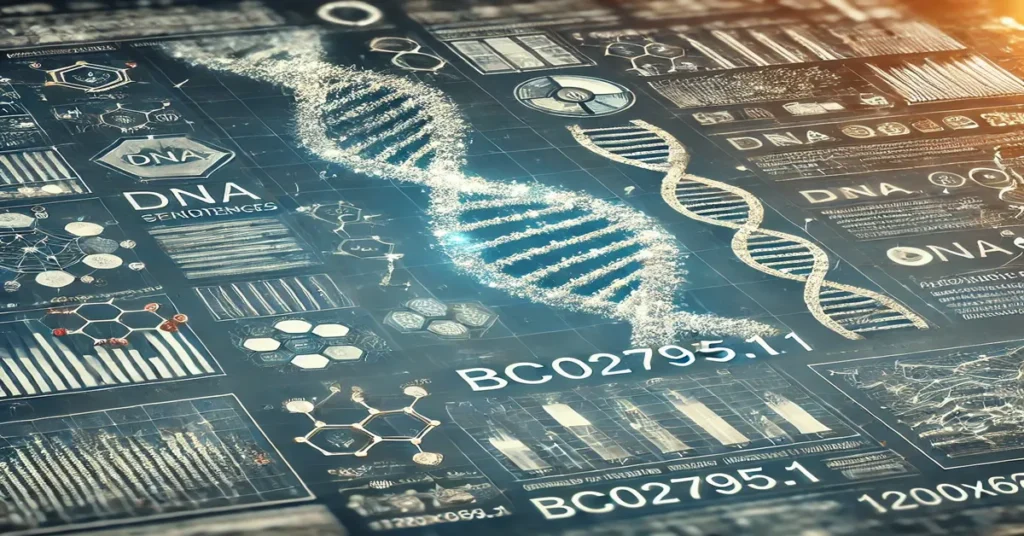Genomic sequences serve as blueprints for life, providing detailed instructions on biological structure, function, and heredity. One such sequence, BC027955.1, holds a unique place in genetic research. With increasing exploration into its role and function, this guide aims to comprehensively address what is currently known about BC027955.1, covering its structure, functions, and potential research and clinical applications. By examining its role within the genome, we can better understand the molecular mechanisms underlying genetic expression, regulation, and their broader implications.
Table of Contents
- Introduction to BC027955.1
- Genomic Structure and Composition of BC027955.1
- Biological Functions Associated with BC027955.1
- Research Applications and Implications
- Clinical Applications of BC027955.1
- Challenges and Limitations in Studying BC027955.1
- Conclusion
- FAQs on BC027955.1
1. Introduction to BC027955.1
BC027955.1 is an accession number in genetic databases, specifically identifying a genomic sequence that may encode a protein or non-coding RNA. In genomic research, sequences like BC027955.1 provide valuable information for molecular biologists, bioinformaticians, and geneticists who aim to understand genetic function, disease mechanisms, and evolutionary processes.
Sequences are systematically cataloged using accession numbers such as BC027955.1, allowing researchers to track specific sequences across studies and databases. BC027955..1 is likely located within a larger genome, and identifying this sequence’s position can offer insights into its potential functional role. Whether it represents a protein-coding gene, a regulatory region, or another type of genetic element, BC027955..1 is a critical resource for understanding broader biological systems.
2. Genomic Structure and Composition of BC027955.1
Understanding BC027955..1 begins with analyzing its structure. Genomic sequences typically consist of nucleotide bases—adenine (A), thymine (T), cytosine (C), and guanine (G)—which, in specific arrangements, code for proteins or regulate cellular functions.
A. Sequence Length and Position
BC027955.1’s length and specific positioning on a chromosome play vital roles in defining its biological relevance. The sequence’s length may determine whether it forms part of a protein-coding gene, regulatory sequence, or another genomic component. Genes in the human genome generally vary in length, with some genes encoding short proteins or functional RNAs and others encoding larger proteins with complex regulatory regions.
B. Potential Coding and Non-Coding Regions
Genomic sequences are categorized into coding and non-coding regions. Coding regions, or exons, are responsible for encoding amino acids in proteins, while non-coding regions may regulate gene expression, RNA splicing, or other essential cellular processes. Research into BC027955..1 focuses on identifying whether it is primarily composed of exons, introns (non-coding intervening sequences), or regulatory elements like promoters or enhancers.
C. Functional Domains and Motifs
Functional domains in proteins perform specific roles, such as DNA binding, enzymatic activity, or protein-protein interactions. Identifying motifs or conserved regions within BC027955..1 helps predict its role in cellular processes. For example, sequences rich in specific nucleotide patterns may indicate a regulatory role in gene expression.
3. Biological Functions Associated with BC027955.1
BC027955.1 may contribute to cellular processes depending on its location, sequence composition, and coding potential. Current research suggests several biological roles that BC027955..1 may play, particularly in cellular signaling, metabolic pathways, and genetic regulation.
A. Gene Expression and Regulation
If BC027955.1 is part of a protein-coding gene, it may participate directly in gene expression. Proteins encoded by such genes can serve as transcription factors, enzymes, or structural proteins. Alternatively, if BC027955..1 serves as a non-coding RNA (ncRNA), it may play a regulatory role, possibly influencing gene silencing, transcription, or RNA splicing.
B. Potential Role in Developmental Processes
Sequences similar to BC027955..1, which encode regulatory proteins or ncRNAs, often contribute to developmental processes, guiding cellular differentiation and tissue specialization. Studies on related sequences suggest that BC027955..1 might be implicated in cell cycle control, cellular signaling pathways, or embryonic development.
C. Involvement in Cellular Stress Responses
Genetic sequences involved in cellular stress responses, such as oxidative stress or DNA damage repair, are critical for maintaining genomic stability. BC027955..1, if it encodes proteins or functional RNAs associated with stress responses, could help the cell adapt to environmental challenges by modulating stress-responsive genes.
4. Research Applications and Implications
BC027955..1 offers potential research applications, especially for understanding gene regulation, protein function, and disease pathways.
A. Bioinformatics and Genetic Modeling
Researchers use bioinformatics tools to predict the structure, function, and evolutionary history of sequences like BC027955..1. Computational modeling allows for the exploration of protein folding, active site prediction, and interactions with other biomolecules, aiding in functional analysis.
B. Functional Genomics
BC027955..1’s role can be studied in functional genomics, where techniques like CRISPR-Cas9 gene editing, RNA interference, and gene knockout studies help identify the effects of specific sequences on cellular functions. Functional genomics provides a way to validate hypotheses derived from bioinformatics studies by observing BC027955..1 in cellular or animal models.
C. Comparative Genomics
By comparing BC027955.1 to analogous sequences in other organisms, researchers can identify conserved elements, shedding light on its evolutionary importance. Conserved sequences often indicate essential biological functions, and their study can help identify critical molecular mechanisms shared across species.
D. Protein-Protein Interactions and Structural Studies
If BC027955..1 encodes a protein, studying its interactions with other proteins is essential for understanding its biological role. Techniques like yeast two-hybrid screening, immunoprecipitation, and X-ray crystallography allow scientists to determine the structure of protein complexes, which can clarify how BC027955..1 contributes to cellular processes.
5. Clinical Applications of BC027955.1
With the potential for various biological roles, BC027955..1 could have significant clinical implications, particularly if linked to specific diseases or therapeutic targets.
A. Disease Association and Genetic Testing
Identifying mutations or variations in BC027955..1 could be relevant for diagnosing genetic disorders or predispositions to disease. Genetic testing may detect alterations in BC027955..1 that correlate with specific diseases, potentially offering early diagnostic insights.
B. Drug Discovery and Development
Sequences involved in regulatory processes or encoding therapeutic targets are valuable for drug discovery. If BC027955.1 encodes a protein or functional RNA associated with disease pathways, it may serve as a target for small molecules, antibodies, or RNA-based therapies. Drug screening can identify compounds that modulate BC027955.1’s function, potentially leading to novel treatments.
C. Gene Therapy and Personalized Medicine
Gene therapy aims to correct defective genes responsible for disease development. If BC027955.1 is implicated in specific genetic disorders, gene-editing approaches may offer therapeutic solutions. Personalized medicine, which tailors treatments based on genetic information, may use BC027955..1 as a biomarker for selecting effective interventions.
6. Challenges and Limitations in Studying BC027955.1
Despite advancements, studying sequences like BC027955..1 comes with challenges, especially in determining its precise function and clinical relevance.
A. Experimental and Technical Limitations
Analyzing BC027955..1 requires advanced techniques, such as next-generation sequencing, gene-editing, and functional assays. Technical limitations in these methods can hinder functional validation, especially for sequences with subtle regulatory effects or low expression levels.
B. Interpretation of Functional Data
A major challenge is distinguishing between causal and correlative roles. For instance, variations in BC027955..1 may be linked to diseases, but proving a causal relationship requires extensive experimentation, often involving animal models and large population studies.
C. Ethical and Regulatory Considerations
If BC027955..1 is associated with genetic testing or therapy, ethical issues may arise, including privacy, informed consent, and equitable access to treatment. Regulatory frameworks must ensure that BC027955..1’s applications in healthcare are safe, ethical, and effective.
Conclusion
BC027955.1 is more than a genomic sequence; it represents a potential gateway to understanding complex biological systems, disease mechanisms, and therapeutic solutions. While still in the early stages of exploration, BC027955..1 demonstrates the vast potential of genomic research, particularly for advancing personalized medicine, understanding cellular regulation, and developing targeted therapies.
As our knowledge of BC027955.1 expands, so will its applications in genetic testing, drug discovery, and gene therapy. Continued research into BC027955..1 will provide deeper insights into genetic function and regulation, ultimately contributing to the broader field of genomics and personalized healthcare.
FAQs on BC027955.1
- What is BC027955.1 in genetics?
- BC027955.1 is an accession number assigned to a specific genomic sequence, likely associated with encoding a protein or functional RNA. It serves as a unique identifier for researchers to study its structure, function, and potential role in biological processes.
- Is BC027955.1 associated with any specific diseases?
- Current research has not definitively linked BC027955.1 to specific diseases. However, further studies may reveal associations with genetic disorders or disease pathways if mutations or variations are found to influence cellular function or regulation.
- Can BC027955.1 be used in genetic testing?
- Potentially, yes. If BC027955.1 is associated with genetic predispositions or mutations linked to disease, it could be used as a biomarker in genetic testing to assess health risks or diagnose conditions.
- How is BC027955.1 studied in the lab?
- Researchers use bioinformatics tools, genetic editing techniques (such as CRISPR), and functional assays to study BC027955.1. These methods help clarify its role, interactions, and possible applications in medicine.
- What applications might BC027955.1 have in medicine?
- BC027955.1 may have applications in drug discovery, gene therapy, and personalized medicine. If associated with specific disease pathways, it could be targeted for therapeutic interventions or used as a diagnostic marker.
- What challenges are involved in researching BC027955.1?
- Challenges include technical limitations, interpreting functional data accurately, and ethical considerations related to genetic testing or therapy. These obstacles can complicate research and the translation of findings into clinical applications.







